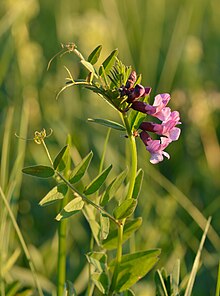Vicia sepium
| Vicia sepium | |
|---|---|
 |
|
| Scientific classification | |
| Kingdom: | Plantae |
| (unranked): | Angiosperms |
| (unranked): | Eudicots |
| (unranked): | Rosids |
| Order: | Fabales |
| Family: | Fabaceae |
| Genus: | Vicia |
| Species: | V. sepium |
| Binomial name | |
|
Vicia sepium L. |
|
Vicia sepium or bush vetch is a plant species of the genus Vicia. A nitrogen-fixing, perennial, leguminous climbing plant that grows in hedgerows, grasslands, the edges of woodland, roadsides and rough ground. Occurs in western Europe, Russia including Siberia, Crimea, Caucasus and Central Asia. Also eastern Canada, north-eastern states of the USA and, where suitable habitat occurs, in Greenland. Found throughout England and eastern parts of Wales.
A rhizomatous plant. Its climbing habit is enabled by branched tendrils at the end of each leaf stem, which curl around surrounding plants. The stems are not branched, are almost glabrous, sometimes with rare soft hairs, single, mostly 30 to 40 cm long but sometimes as much as 100 cm. The leaves are compound and pinnate with 4 to 8 pairs of opposite leaflets ending in branched tendrils. Leaflets are 20 to 30 mm long, 8 to 10 mm wide, elongated elliptical in form with broad bases and glabrous at both sides. Flower stalks are very short with 2 to 6 almost sessile flowers on each. Flowers are 12 to 15 mm long, reddish-lilac or lilac-blue. Similar in appearance to common vetch (Vicia sativa) but each stem of the latter has more flowers, and bush vetch is usually hairless whereas V. sativa is slightly hairy.
Flowers between May to August, occasionally into November. Mainly cross pollinated by insects. The resultant pods or legumes ripen mainly during July to August, are 30 to 40 mm long, 6 to 8 mm wide, elongated, rhomboid and black in colour. The seeds within are black or brown.
A good potential forage crop with high nutritional value, characterized by high seed productivity in less favourable years. Can by used for hay or silage, particularly arable silage, from perennial grass-vetch mixtures.
Bush vetch supports a variety of generalist legume feeders including beetles, weevils and caterpillars. Bumblebees and honeybees seek out the flowers for their nectar.
Hedges and grasses thickets.
...
Wikipedia
